 Heights of Reflection
Heights of Reflection Book contents
- Frontmatter
- Contents
- Acknowledgments
- Introduction: The Meaning of Mountains: Geology, History, Culture
- Prelude: Classical Mountain Landscapes and the Language of Ascent
- Part I First Forays: Mountain Exploration and Celebration from the Middle Ages to the Eighteenth Century
- Part II Beckoning Heights: Summits Near and Far in the Nineteenth Century
- Fascinating Voids: Alexander von Humboldt and the Myth of Chimborazo
- From Eros to Thanatos: Hiking and Spelunking in Ludwig Tieck's Der Runenberg
- Geology, Mountaineering, and Self-Formation in Adalbert Stifter's Der Nachsommer
- “An Apparition from Another World”: The Mountains of the Moon and Kilimanjaro from the Perspective of Nineteenth-Century Germany
- Part III Modern Expeditions and Evocations: Climbing from the Twentieth into the Twenty-First Century
- Works Cited
- Notes on the Contributors
- Index
Fascinating Voids: Alexander von Humboldt and the Myth of Chimborazo
from Part II - Beckoning Heights: Summits Near and Far in the Nineteenth Century
Published online by Cambridge University Press: 05 February 2013
- Frontmatter
- Contents
- Acknowledgments
- Introduction: The Meaning of Mountains: Geology, History, Culture
- Prelude: Classical Mountain Landscapes and the Language of Ascent
- Part I First Forays: Mountain Exploration and Celebration from the Middle Ages to the Eighteenth Century
- Part II Beckoning Heights: Summits Near and Far in the Nineteenth Century
- Fascinating Voids: Alexander von Humboldt and the Myth of Chimborazo
- From Eros to Thanatos: Hiking and Spelunking in Ludwig Tieck's Der Runenberg
- Geology, Mountaineering, and Self-Formation in Adalbert Stifter's Der Nachsommer
- “An Apparition from Another World”: The Mountains of the Moon and Kilimanjaro from the Perspective of Nineteenth-Century Germany
- Part III Modern Expeditions and Evocations: Climbing from the Twentieth into the Twenty-First Century
- Works Cited
- Notes on the Contributors
- Index
Summary
When Alexander von Humboldt reached the village of Calpi in the Andes on 22 June 1802, he was greeted with reverence and enthusiasm. Triumphal arches adorned with cotton, cloth, and silver decorated his path. The natives performed a dance in festive dress. A singer praised the explorer's expedition, which had departed three years earlier from the Spanish port of La Coruña. Like Odysseus on the isle of the Phaeacians, the traveler listened to a local rhapsodist singing about his heroic deeds. Before his adventure ended, it had already spun a popular myth.
This episode, which Humboldt recorded in his diary, occurred at a significant moment. One day later, the “Second Discoverer of America” rose to even greater fame on an excursion marking in more ways than one the climax of his enterprise. Humboldt set out to climb Chimborazo (6,310 m/20,702 ft.), the mountain then thought to be the highest in the world. He was accompanied by the French botanist Aimé Bonpland (1773–1858) and the Creole nobleman and future activist Carlos Montúfar (1780–1816), as well as native guides and assistants. They climbed to heights never reached before, setting a new record and catapulting Humboldt to fame on both continents.
Myths
The ascent of Chimborazo had a great symbolic significance. A man of the Enlightenment reaching uncharted altitudes inspired contemporary artists such as Friedrich Georg Weitsch (1810) and Karl von Steuben (1812/21) to paint Humboldt in promixity to the mountain.
- Type
- Chapter
- Information
- Heights of ReflectionMountains in the German Imagination from the Middle Ages to the Twenty-First Century, pp. 153 - 175Publisher: Boydell & BrewerPrint publication year: 2012
